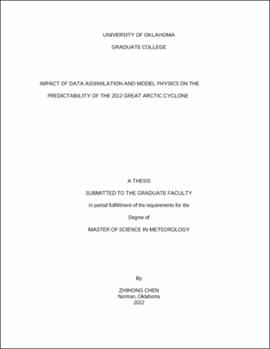| dc.description.abstract | Impact of data assimilation and model physics on the predictability of the 2012 Great Arctic Cyclone
A case study of the Great Arctic Cyclone 2012 (AC12) is used to understand the role of initial condition errors and model physics errors in the 2-3-day range predictability of high-impact summer Arctic Cyclones (ACs). The control forecasts initialized with analyses assimilating conventional in-situ observation demonstrate improved skills in predicting the peak intensity with less than 3 hPa difference from the verifying reanalysis. However, the forecasted AC12 reaches its peak intensity 18 hours earlier than in the verifying reanalysis and the cyclone track is biased towards the southwest. Using ensemble sensitivity analysis (ESA), the upstream trough, downstream ridge, and the tropopause polar vortex (TPV) to the northeast (NE TPV) of the AC12 are identified to be correlated with the deepening trend and the cyclone track error, but they are not well observed by current in-situ observation networks. Pseudo-observations are constructed from reanalysis and are added to the three features separately to study the impact of the initial condition error in each feature on the predictability of AC12. The cyclone deepening trend error and track error are greatly reduced when the initial condition is better constrained in either the NE TPV or the jet stream wind along the trough and ridge, as the former leads to a southward expansion of the NE TPV and the latter leads to successfully capturing of a shortwave trough at the 2PVU surface above the AC12. Varying the choice of model physics parameterization schemes does not further improve the cyclone track prediction. The cyclone intensity prediction is sensitive to the choice of longwave radiation schemes and planetary boundary layer (PBL) schemes. Varying longwave radiation schemes creates a large ensemble spread (~5 hPa) in the cyclone intensity prediction as the longwave cooling gradient near the tropopause affects the strength of TPVs. The Yonsei University (YSU) PBL scheme further improves the prediction of the deepening trend and sustained intensity of AC12, as it reduces the PBL model physics error of the convection in the lower-tropopause front areas compared to the Mellor–Yamada–Nakanishi–Niino scheme widely used for Arctic. The choice of shortwave radiation schemes and microphysics schemes is found to have little impact on the predictability of AC12. These results have implications for further improvements in the intensity and track prediction of ACs at shorter time scales to better serve the growing human activity in the Arctic.
Key words: Arctic Cyclones, data assimilation, physics parameterization, EnKF | en_US |
